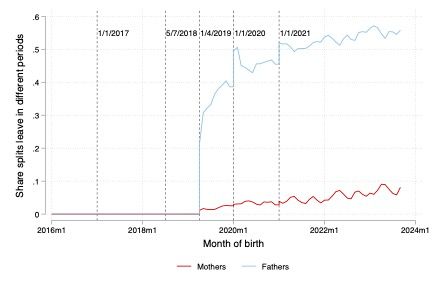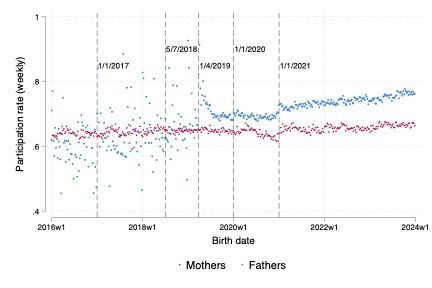@libertadgonzalez.bsky.social , @lidiafarre.bsky.social and Jenifer Ruiz-Valenzuela! 🙌
@libertadgonzalez.bsky.social , @lidiafarre.bsky.social and Jenifer Ruiz-Valenzuela! 🙌
Spain’s reforms offer a compelling case for how policy can change behavior - fast.
And they raise big questions for countries still treating paternity leave as optional or symbolic.
Full paper 👉 cep.lse.ac.uk/_NEW/PUBLICA...
@EconTwitter @GenderEcon #EconTwitter
Spain’s reforms offer a compelling case for how policy can change behavior - fast.
And they raise big questions for countries still treating paternity leave as optional or symbolic.
Full paper 👉 cep.lse.ac.uk/_NEW/PUBLICA...
@EconTwitter @GenderEcon #EconTwitter
Evidence on short-run labor market effects is mixed.
But there’s growing hope that paternity leave may shift long-term gender norms, reduce the child penalty, and promote care equality — if properly designed.
Evidence on short-run labor market effects is mixed.
But there’s growing hope that paternity leave may shift long-term gender norms, reduce the child penalty, and promote care equality — if properly designed.
Three key features stand out:
✔️ Mandatory initial weeks
✔️ Equal duration for fathers and mothers
✔️ No shared/transferable leave (only earmarked)
Three key features stand out:
✔️ Mandatory initial weeks
✔️ Equal duration for fathers and mothers
✔️ No shared/transferable leave (only earmarked)
Access to flexibility and job protection still reflects inequality.
Access to flexibility and job protection still reflects inequality.
Flexibility matters — and fathers are increasingly tailoring leave to family needs.
Flexibility matters — and fathers are increasingly tailoring leave to family needs.
This was non-existent in 2018.
Splitting likely allows fathers to be home after mothers return to work, helping delay the transition to formal childcare.

This was non-existent in 2018.
Splitting likely allows fathers to be home after mothers return to work, helping delay the transition to formal childcare.
After each extension, they immediately adjusted.
Our DiD estimates show significant jumps in leave duration after every reform — a strong behavioral response.

After each extension, they immediately adjusted.
Our DiD estimates show significant jumps in leave duration after every reform — a strong behavioral response.
As the graph shows, since 2019, when some weeks of leave became mandatory, a higher share of fathers is taking leave than mothers. Why? Because of strong eligibility gaps (mothers work < than fathers).

As the graph shows, since 2019, when some weeks of leave became mandatory, a higher share of fathers is taking leave than mothers. Why? Because of strong eligibility gaps (mothers work < than fathers).
Today, fathers get 16 weeks of paid, non-transferable leave, the same as mothers.
And this isn’t just on paper. Fathers are taking it.

Today, fathers get 16 weeks of paid, non-transferable leave, the same as mothers.
And this isn’t just on paper. Fathers are taking it.

